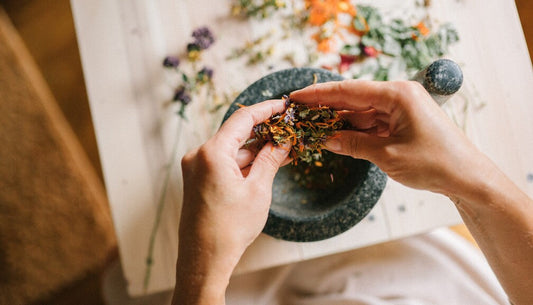During the winter season and holidays, many of us have the tendency to want to stay inside, snuggle up, share cookies, food, and wine with friends and family. While having small amounts of our favorite holiday treats is an innocent celebration, if we over-indulge for too long, we will inevitably start facing the consequences of imbalance and the increase of toxins.
Bhagavat, the author of the Aṣṭāṅga Hṛdayam, describes the indications of āma (toxins) in his classical Ayurvedic text:
“The signs and symptoms of āma are the clogging of the channels, destruction of strength, a sense of heaviness, misguided Vata (gas), lethargy, indigestion, Kapha-type congestion, accumulation of the three wastes, a loss of taste, and exhaustion.” (Va. Su. 13)
To reduce āma, Ayurveda provides us with seven methods of Palliative Therapies, or Shamana Chikitsā, as tools for cleansing. For each dosha, there are specialized protocols that can be taken to reduce toxins without aggravating the individual constitution.
This is one of the most principle aims of Ayurveda, as maintaining a strong but balanced agni, or digestive fire, is the key to optimum health and fundamental to preventing disease.
There are certain Ayurvedic remedies to help burn up accumulated toxins, even without the help of a naturally strong digestive fire.
There are different forms of fasting that can be appropriate for each dosha type.
Always listen to your body and be aware not to deplete the immune system due to under-nourishment, which will lead to acute seasonal cold and flus.
It is important to stay hydrated, so fasting from liquid is only used in very specific conditions not discussed here; however, there are general rules for liquid consumption that can be followed to avoid toxin buildup.
All three doshas should avoid consuming large amounts of water right before meals and within an hour after meals. Iced drinks should be avoided by all doshas as they will smother the digestive fire and build āma. On the other hand, sipping hot water or herbal tea throughout the day stokes agni and burns toxins.
This is one we all know about, but often neglect during the holiday season.
This is especially important in the winter, as days become shorter and we want to avoid the seasonal blues.
If you are doing the previous two Chikitsās, then it is very likely that you are also getting exposure to fresh air while basking in the sun and/or exercising. There are also certain breathing exercises that will benefit each dosha.
This holiday season, you can start experimenting with one, several, or all the seven types of Palliative Therapies to keep your toxins at bay all winter long. When you start feeling the signs and symptoms of āma, you now have the tools to reduce your toxins with these simple at-home Ayurvedic remedies for your dosha. That way, you can have your cake and agni too.
Give yourself the gift of six days dedicated to relaxation, detoxification, and healing at the Chopra Health Retreat at CIVANA.
Understanding the Nature of Toxins
Bhagavat, the author of the Aṣṭāṅga Hṛdayam, describes the indications of āma (toxins) in his classical Ayurvedic text:
“The signs and symptoms of āma are the clogging of the channels, destruction of strength, a sense of heaviness, misguided Vata (gas), lethargy, indigestion, Kapha-type congestion, accumulation of the three wastes, a loss of taste, and exhaustion.” (Va. Su. 13)
To reduce āma, Ayurveda provides us with seven methods of Palliative Therapies, or Shamana Chikitsā, as tools for cleansing. For each dosha, there are specialized protocols that can be taken to reduce toxins without aggravating the individual constitution.
The Seven Methods of Palliative Therapies
1. The first form of Shamana Chikitsā is Dīpana, or Kindling the Digestive Fire.
This is one of the most principle aims of Ayurveda, as maintaining a strong but balanced agni, or digestive fire, is the key to optimum health and fundamental to preventing disease.
- For Vata’s irregular appetite, eat a ginger appetizer 30 minutes before each meal to induce hunger and jumpstart gastric secretions in Vata’s dry digestive tract. This is prepared by slicing or grating a ½ tsp. size chunk of fresh ginger, adding a squeeze of fresh lemon juice, and topping it off with a pinch of salt.
- While Pittas have a strong appetite, this does not necessarily equate to good digestion. Since hunger is already present, our aim in Pitta dīpana is to improve the quality of the agni throughout all stages of digestion. When the liquid quality of Pitta creates an overly sharp (but unsustainable) agni, Pitta’s can balance their raging gastric fire by mixing equal parts of Coriander, Cumin, and Fennel powder, then taking ¼ tsp. 30 minutes before meals.
- For Kapha’s slow metabolism, we aim to ignite the low digestive fire in the stomach, the home-site of Kapha, which is dampened by mucus. This can be remedied by drinking ACV Tea in the morning, 30 minutes before food or coffee. It is prepared by mixing 8 oz. of warm water, 7-10 drops of apple cider vinegar, and 1 tsp. honey. This mixture will jump-start the metabolism of Kaphas, to induce real hunger and kick sweet cravings.
2. The second type of Shamana Chikitsā is called Pāchana, Burning āma.
There are certain Ayurvedic remedies to help burn up accumulated toxins, even without the help of a naturally strong digestive fire.
- Vatas can take ¼ tsp. of Hingvastak Churna after meals (or sprinkled on meals as a seasoning) to prevent gas, bloating and indigestion that comes from heavy, hard-to-digest holiday meals which are difficult for delicate Vata digestion.
- Pittas experiencing GERD, acid indigestion or nausea from oily, excessive holiday feasts can take ½ tsp. Avipattikar Churna after lunch.
- Kaphas can take ¼ tsp. of Trikatu after meals, or season meals with this mixture of “three spicy” herbs: ginger, black pepper, and long pepper, to burn their thick, sticky ama.
3. The third type of Shamana Chikitsā is Kshut Nigraha, Fasting.
There are different forms of fasting that can be appropriate for each dosha type.
- Vatas should avoid total fasting because it will be too lightening and depleting for their delicate body types. Rather than skipping meals, they can choose to do a mono-diet of soft, soupy roots and vegetables, and moist mung dal Kitchari with warming spices for 3 days.
- While Pittas hate fasting because their intense appetites, moderate fasting can benefit them. Pitta’s can follow a mono-diet of Kitchari with Pitta-reducing spices and/or Congee (rice porridge) with steamed vegetables for 3 to 5 days. Avoid the urge to overeat, and only eat the amount of food that would fit inside your cupped palms.
- Kaphas are the best at fasting, as they have the most stamina and strength in their constitution. Kapha’s can easily skip meals, so fasting for them is very beneficial for kindling agni and making them feel lighter. For a seasonal Kapha fast, try to eat just one main meal per day during lunch time for 5 to 7 days. Skip breakfast and eat a light dinner of pureed vegetable soup, if necessary.
Always listen to your body and be aware not to deplete the immune system due to under-nourishment, which will lead to acute seasonal cold and flus.
4. The fourth type of Shamana Chikitsā is Trut Nigraha, or avoiding excess fluid intake.
It is important to stay hydrated, so fasting from liquid is only used in very specific conditions not discussed here; however, there are general rules for liquid consumption that can be followed to avoid toxin buildup.
All three doshas should avoid consuming large amounts of water right before meals and within an hour after meals. Iced drinks should be avoided by all doshas as they will smother the digestive fire and build āma. On the other hand, sipping hot water or herbal tea throughout the day stokes agni and burns toxins.
5. The fifth type of Shamana Chikitsā is Vyāyāma, or exercise.
This is one we all know about, but often neglect during the holiday season.
- Vatas should favor gentle, slow movements like Thai Chi and Qi Gong.
- Pittas, in the winter season, can enjoy outdoor sports that will not overheat them. Examples are cross country skiing, snowboarding, and snowshoeing. In the summer or more tropical locations, Pittas can go for swimming or surfing as hobbies, and participate in group sports like volleyball.
- Kaphas should do vigorous and heating exercises that promote sweating, such as jogging, jumping rope and cardio, especially where heavy breathing is involved to expectorate excess mucus from the lungs. They can also try hot vinyasa yoga to stimulate circulation and feel energized and light.
6. The sixth form of Shamana Chikitsā is Ātapa Seva, or exposure to sunlight.
This is especially important in the winter, as days become shorter and we want to avoid the seasonal blues.
- Vatas need the warmth of the sun but should be sure to bundle up if the weather is cool wearing hats and scarves to protect Vata-sensitive areas of the ears and throat. If it is too chilly outside for thin Vata skin, try sunbathing in your sweats inside the comfort of your home near a bay window or in a sunroom.
- Fiery Pittas will reap benefits of Chandra Seva, or moon-bathing. While it might be too frigid to spend much time outside at night during winter months where you are, consider going on moonlit walks close to the full moon time. To chill out sharp Pitta emotions like anger and frustration, gaze up at the night sky on a short moon lit walk or stargaze for constellations and the Milky Way.
- Kaphas have thicker skin to endure the chilly winter weather, so think about multi-tasking this protocol with exercise by getting out for a morning walk while catching rays. Kaphas will tend to get depressed if not exposed to enough sunlight, so if you live in a place that is generally overcast during winter months, take advantage of every chance you get to soak up the sun.
7. The seventh type of Shamana Chikitsā is Maruta Seva, or exposure to fresh air and pranayama.
If you are doing the previous two Chikitsās, then it is very likely that you are also getting exposure to fresh air while basking in the sun and/or exercising. There are also certain breathing exercises that will benefit each dosha.
- Vatas can practice Bhrāmarī Prāṇāyāma (Bees Breath), along with Anulom Vilom, (Alternate Nostril Breathing) to soothe the nervous system and still the mind. These Prāṇāyāmas will re-center the Vayus and allow Vatas a chance to recenter and relax amidst the business of the holiday season.
- When Pittas become critical, irritable, Bah-Humbuggy Scrooges during the holidays, they can time-out to chill and practice Shītalī Prāṇāyāma by rolling your tongue up in a little straw shape and breathing in and out through the tongue for 12 breaths.
- Kaphas tend to accumulate emotions of depression and sadness in the lungs. So, try heating and expectorating Prāṇāyāmas in the morning like Kapālabhāti or Bhastrika* that will stimulate circulation and energize the mind. *Always consult with your healthcare practitioner before practicing Kapālabhāti or Bhastrika.
Staying Balanced During the Holiday Season
This holiday season, you can start experimenting with one, several, or all the seven types of Palliative Therapies to keep your toxins at bay all winter long. When you start feeling the signs and symptoms of āma, you now have the tools to reduce your toxins with these simple at-home Ayurvedic remedies for your dosha. That way, you can have your cake and agni too.
Give yourself the gift of six days dedicated to relaxation, detoxification, and healing at the Chopra Health Retreat at CIVANA.






















